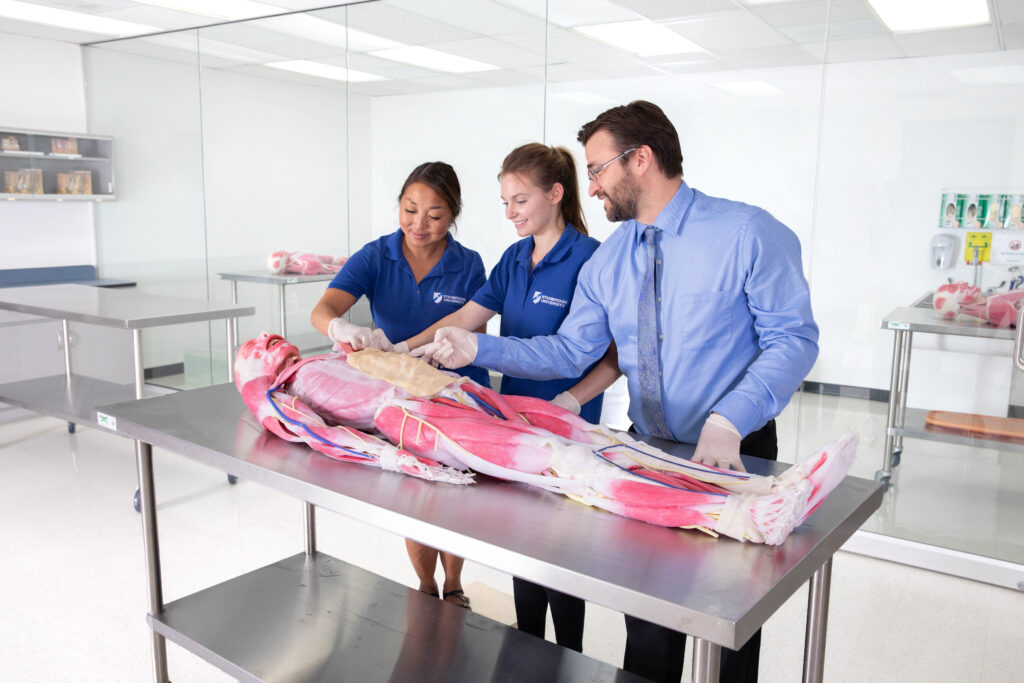Nursing Explained: The Roles, Responsibilities & Real Impact
TL;DR
- Nurses are the backbone of healthcare, assessing patients, administering treatments, performing essential nursing procedures, and providing education and emotional support. Their impact extends from hospitals to community settings, shaping patient outcomes through skill, compassion, and collaboration.¹
- Future nurses from Stanbridge University can choose between the Licensed Vocational Nurse (LVN) program for an earlier start in patient care or the Bachelor of Science in Nursing (BSN) program for a deeper clinical and leadership foundation.
- For graduates ready to advance further, the Master of Science in Nursing Education (MSN-Ed) program offers the next step. Whether your goal is bedside care or leadership, nursing offers a purposeful career that makes a lasting difference.
Stanbridge University students gain hands-on experience in the nursing lab as they get practical answers to the question “what do nurses do” through guided instruction and clinical simulation.
Nursing is often described as the heart of healthcare, and for good reason. Nurses are the ones who stay at a patient’s bedside, explain treatments, coordinate care, and support families in vulnerable moments.¹ But, exactly what do nurses do? It’s a question with more depth than most people realize.
Nurses assess, treat, educate, advocate, and support patients through every stage of care. Whether working in hospital units, community clinics, or long-term care facilities, nurses bring together clinical expertise and compassionate communication to support healing and recovery.¹
This blog post explores the many roles nurses take on, the procedures they perform, the environments they work in, and how their impact shapes healthcare.
What Do Nurses Do in Hospitals and Beyond?
First, what do nurses do in hospitals? According to the Bureau of Labor Statistics, the nursing role spans a wide range of responsibilities. In these high-pressure environments, nurses assess patient conditions, administer medications, monitor vital signs, manage IVs, assist with procedures, and document changes.² They are often the first to notice subtle shifts in a patient’s condition and play a key role in relaying that information to physicians.¹
Outside of hospitals, nurses provide care in outpatient centers, schools, and long-term care facilities. No matter the location, they serve as essential care providers who help patients navigate everything from acute illness to chronic conditions.¹
If you’re considering an earlier path into patient care, learn why the LVN program is often a strong stepping stone by checking out Vocational Nursing (LVN) Programs as a Steppingstone.
Common Nursing Procedures and Patient Care Tasks
What is the main role of the nurse? A nurse’s role includes many technical and hands-on responsibilities. Across every care setting, they perform nursing procedures that range from dressing wounds and drawing blood to managing catheters, administering injections, and preparing patients for surgery.¹
Rather than being just clinical checklists, these procedures are critical to maintaining patient safety, comfort, and health outcomes. Nurses are trained to perform them with accuracy, all while responding to the physical and emotional needs of the people in their care.¹
The Real Impact of Nurses on Patient Outcomes
Nurses provide education, emotional reassurance, and preventative guidance.¹ Because of their ongoing presence, nurses are uniquely positioned to build trust with patients and families. They can contribute to reduced readmission rates, improve satisfaction scores, and ensure that care plans are followed inside and outside of the hospital setting.
Pathways into Nursing: Education and Training at Stanbridge University
There’s more than one path into nursing, and each one prepares you for a unique level of care, responsibility, and growth. Stanbridge University offers two nursing programs: the Licensed Vocational Nurse (LVN) program and the Bachelor of Science in Nursing (BSN) program. LVNs are qualified to provide bedside care under the supervision of registered nurses or physicians.²
The LVN path is ideal for those who want to begin working with patients sooner.³ Not sure whether the LVN or RN path fits your goals? Explore our comparison post “LVN vs. RN: Which Nursing Program Is Right for Me?” to help you weigh your options. Training emphasizes practical skills like monitoring vital signs, assisting with hygiene, and maintaining health records, which are essential responsibilities in hospitals, long-term care, and outpatient settings.¹
What do nurses do after their training? They may take up roles in healthcare institutions or opt for career advancement through further education.
The BSN program covers leadership, evidence-based practice, and health promotion. BSN graduates are prepared for RN-level responsibilities, from managing care plans to educating patients and collaborating with medical teams.¹ For those who want to grow into educator or mentor roles, the Master of Science in Nursing Education (MSN-Ed) program at Stanbridge University builds on the BSN foundation, offering the next step toward long-term career advancement.
The MSN-Ed program is available at no cost to Stanbridge University Bachelor of Science in Nursing graduates who began their program on or after August 2024 and who enroll in the Master of Science in Nursing Education program beginning immediately after graduating and obtaining their NCLEX-RN licensure.⁴
Nurses as the Heart of Healthcare
In a nutshell, what do nurses do? They lead, listen, guide, and care. They are the steady hands during a crisis and the trusted voices during recovery. Through a blend of technical skill and human connection, nurses are often the reason patients feel supported during life’s most difficult moments. If you’re looking to build a career that makes a measurable difference, nursing offers a future filled with purpose, challenge, and impact.
Visit the Stanbridge University BSN program page to learn more about the specifics of this program. You can also contact us directly for one-on-one assistance.
Frequently Asked Questions
Nurses assess, treat, educate, advocate, and support patients through every stage of care. They combine clinical expertise with human connection to improve health outcomes in hospitals, clinics, and beyond.¹
A nurse’s role includes many technical and hands-on responsibilities. Across every care setting, they perform nursing procedures that range from dressing wounds and drawing blood to managing catheters, administering injections, and preparing patients for surgery.¹
The nursing role spans a wide range of responsibilities. In these high-pressure environments, nurses assess patient conditions, administer medications, monitor vital signs, manage IVs, assist with procedures, and document changes.¹
¹Source: Bureau of Labor Statistics, U.S. Department of Labor, Occupational Outlook Handbook, Registered Nurses, https://www.bls.gov/ooh/healthcare/registered-nurses.htm. As viewed on August 15, 2025.
²Source: Bureau of Labor Statistics, U.S. Department of Labor, Occupational Outlook Handbook, Licensed Practical and Licensed Vocational Nurses, https://www.bls.gov/ooh/healthcare/licensed-practical-and-licensed-vocational-nurses.htm. As viewed on August 15, 2025.
³Program duration subject to change. Completion times vary depending on the start and end dates of a cohort and any individual circumstances that may impact progression.
⁴The MSN-Ed program is available at no cost to Stanbridge University Bachelor of Science in Nursing graduates who began their program on or after August 2024 and who enroll in the Master of Science in Nursing Education program beginning immediately after graduating and obtaining their NCLEX-RN licensure.


